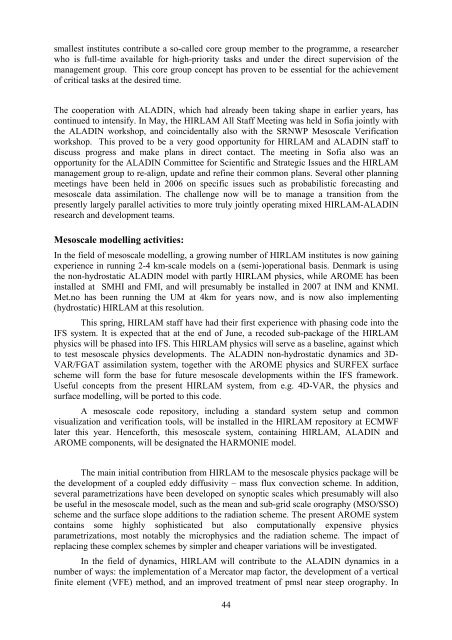Proceedings - C-SRNWP Project
Proceedings - C-SRNWP Project
Proceedings - C-SRNWP Project
Create successful ePaper yourself
Turn your PDF publications into a flip-book with our unique Google optimized e-Paper software.
smallest institutes contribute a so-called core group member to the programme, a researcher<br />
who is full-time available for high-priority tasks and under the direct supervision of the<br />
management group. This core group concept has proven to be essential for the achievement<br />
of critical tasks at the desired time.<br />
The cooperation with ALADIN, which had already been taking shape in earlier years, has<br />
continued to intensify. In May, the HIRLAM All Staff Meeting was held in Sofia jointly with<br />
the ALADIN workshop, and coincidentally also with the <strong>SRNWP</strong> Mesoscale Verification<br />
workshop. This proved to be a very good opportunity for HIRLAM and ALADIN staff to<br />
discuss progress and make plans in direct contact. The meeting in Sofia also was an<br />
opportunity for the ALADIN Committee for Scientific and Strategic Issues and the HIRLAM<br />
management group to re-align, update and refine their common plans. Several other planning<br />
meetings have been held in 2006 on specific issues such as probabilistic forecasting and<br />
mesoscale data assimilation. The challenge now will be to manage a transition from the<br />
presently largely parallel activities to more truly jointly operating mixed HIRLAM-ALADIN<br />
research and development teams.<br />
Mesoscale modelling activities:<br />
In the field of mesoscale modelling, a growing number of HIRLAM institutes is now gaining<br />
experience in running 2-4 km-scale models on a (semi-)operational basis. Denmark is using<br />
the non-hydrostatic ALADIN model with partly HIRLAM physics, while AROME has been<br />
installed at SMHI and FMI, and will presumably be installed in 2007 at INM and KNMI.<br />
Met.no has been running the UM at 4km for years now, and is now also implementing<br />
(hydrostatic) HIRLAM at this resolution.<br />
This spring, HIRLAM staff have had their first experience with phasing code into the<br />
IFS system. It is expected that at the end of June, a recoded sub-package of the HIRLAM<br />
physics will be phased into IFS. This HIRLAM physics will serve as a baseline, against which<br />
to test mesoscale physics developments. The ALADIN non-hydrostatic dynamics and 3D-<br />
VAR/FGAT assimilation system, together with the AROME physics and SURFEX surface<br />
scheme will form the base for future mesoscale developments within the IFS framework.<br />
Useful concepts from the present HIRLAM system, from e.g. 4D-VAR, the physics and<br />
surface modelling, will be ported to this code.<br />
A mesoscale code repository, including a standard system setup and common<br />
visualization and verification tools, will be installed in the HIRLAM repository at ECMWF<br />
later this year. Henceforth, this mesoscale system, containing HIRLAM, ALADIN and<br />
AROME components, will be designated the HARMONIE model.<br />
The main initial contribution from HIRLAM to the mesoscale physics package will be<br />
the development of a coupled eddy diffusivity – mass flux convection scheme. In addition,<br />
several parametrizations have been developed on synoptic scales which presumably will also<br />
be useful in the mesoscale model, such as the mean and sub-grid scale orography (MSO/SSO)<br />
scheme and the surface slope additions to the radiation scheme. The present AROME system<br />
contains some highly sophisticated but also computationally expensive physics<br />
parametrizations, most notably the microphysics and the radiation scheme. The impact of<br />
replacing these complex schemes by simpler and cheaper variations will be investigated.<br />
In the field of dynamics, HIRLAM will contribute to the ALADIN dynamics in a<br />
number of ways: the implementation of a Mercator map factor, the development of a vertical<br />
finite element (VFE) method, and an improved treatment of pmsl near steep orography. In<br />
44

















